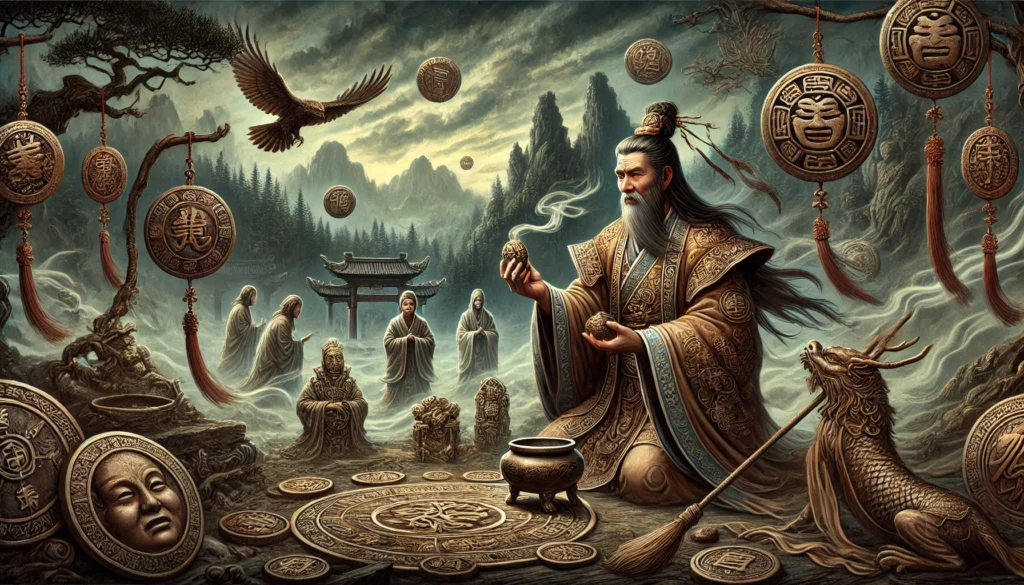The concept of curses, or “curseology,” has roots in Ancient China, dating back to the Xia Dynasty (circa 2070–1600 BCE), a period often shrouded in mystery and legend. Although historical records from this early era are sparse and often intertwined with myth, there are indications that curses played a role in the beliefs and practices of the time. Here’s an exploration of how curse-related practices might have looked in Xia society based on ancient texts, archeological evidence, and historical interpretation.
1. Curses and the Mandate of Heaven
- The Xia Dynasty, as one of China’s earliest dynastic reigns, was steeped in proto-religious beliefs that evolved into what later dynasties would call the Mandate of Heaven. This concept, though more clearly defined in later periods, likely began in the Xia. Misfortunes or natural disasters were often seen as heavenly signs of a ruler’s failing legitimacy, which could be interpreted as a form of divine curse on the ruling class.
- If a king or leader was seen to act unjustly, it was thought that heaven itself could send down curses in the form of droughts, plagues, or other calamities. This belief enforced moral conduct among leaders, as losing the Mandate of Heaven could end their rule.
2. Shamanistic Practices and Protective Charms
- Xia society had a close connection to shamanistic practices. Shamans, or spirit mediums, were revered figures believed to communicate with the divine or ancestral spirits. They were responsible for both issuing curses (often directed at those who transgressed social or spiritual rules) and creating protective charms.
- Artifacts unearthed from this period suggest that early forms of amulets or talismans, often carved with ancient symbols or animal figures, were used to ward off curses and evil spirits. These protective items were worn or placed in the home to guard against misfortune.
3. Role of Ancestral Spirits and Ghosts
- Ancestors held a significant position in Xia beliefs, and maintaining harmony with one’s ancestors was essential. Disrespect toward ancestors was thought to provoke curses, as ancestors had the power to intervene in the world of the living. Rituals were performed to appease the dead, who were believed capable of sending misfortune if they felt neglected.
- Ancestral shrines from this era, sometimes featuring early forms of incantations or offerings, suggest that curses and blessings were tied to one’s relationship with the spirits of deceased family members.
4. Witchcraft and Early Sorcery
- Early forms of witchcraft and sorcery likely existed in the Xia Dynasty. Records from later dynasties reference ancient practices of casting spells or using symbols to influence others, implying that this may have originated as early as the Xia. Objects like bone inscriptions and other ritual tools found in archaeological sites indicate that rituals for controlling or manipulating fate were known, possibly for cursing adversaries or protecting one’s kin.
- Sorcery might have also been a tool for societal control, as rulers or influential figures could employ curses to instill fear and command loyalty.
5. Curses in Myth and Folklore
- The Xia Dynasty is surrounded by myths, and some of these myths describe the powers of curses and the supernatural. For instance, stories of Xia kings being overthrown due to supernatural events or divine retribution could be seen as examples of curses enacted against unjust rulers.
- Early mythological texts like the Classic of Mountains and Seas (Shanhaijing), though compiled later, contain mythic elements that likely originated in Xia or even earlier periods. They describe spirits, gods, and cursed lands, hinting at an ancient understanding of curses within the natural and divine world.
6. Divination and Oracle Bones
- Although oracle bones are more commonly associated with the later Shang Dynasty, early forms of divination practices may have existed in the Xia. Divination was a method to understand and avoid curses, predicting potential misfortunes through rituals that involved bones, stones, or other natural elements.
- Kings and leaders relied on these practices to gain insight into the future, especially regarding warfare, harvests, or health, seeking to ward off negative outcomes or “curses” that might befall the land.
In conclusion, the Xia Dynasty’s history of curseology reflects a mix of religious beliefs, shamanistic practices, and early sorcery. While records are few, the traditions of ancestor worship, belief in divine retribution, and the use of talismans and protective charms illustrate how curses might have influenced Xia society and its rulers’ actions, setting the stage for later dynasties to formalize and expand upon these ancient traditions.
